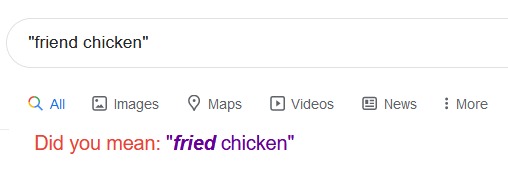Welcome to the pairman.com blog. I hope to add regular posts on language-related matters.
My first post is about the importance of checking that any foreign language you are going to use in public is actually correct.

I recently saw this sign in a town near where I live. It seems a shame that the restaurant commissioned their impressive sign but didn’t take the time to check the spelling. It wouldn’t be too difficult – in fact the easiest way is to use Google. If you put your term between inverted commas (“…”), the search results will only show that exact phrase as you have typed it, not just all examples of web pages containing all the words in the term or phrase you want to check.
If the term isn’t correct or isn’t commonly used in the language in question, you might see very few results or none at all. However, if you have only made a small mistake, Google will often suggest an alternative, as in this case…

As a translator this is something I do all the time to confirm that a term I want to translate is in common use, that it’s “the way that people say it”. However, it’s also extremely useful for anybody writing in a foreign language (or their own!) in any context.
A two-minute Google search would have meant I was talking here about the restaurant’s lovely food and friendly service instead of its funny sign!
Bienvenido al blog de pairman.com. Mi idea es añadir artículos breves periódicamente sobre temas relacionados con el lenguaje y la traducción.
La primera entrada trata sobre la importancia, cuando vas a usar en público cualquier idioma que no es el tuyo, de comprobar que no contenga errores.

Hace poco vi este rótulo bonito cerca de donde vivo. Me parece una lástima que el restaurante lo encargara sin comprobar el inglés (pone “Kebab y Pollo Amigo” en lugar de “Pollo Frito”). No es nada difícil, basta con buscar en Google. Si se escribe el término entre dobles comillas (“…”), la búsqueda sólo muestra los resultados de la frase exacta, tal y como la has tecleado, en lugar de todas las páginas web que tienen todas las palabras del término que quieres comprobar en cualquier orden.
Si el término no es correcto, o no se usa frecuentemente en el idioma en cuestión, no verás ningún resultado o sólo muy pocos. Sin embargo, si el error no es muy grave, Google suele sugerir una alternativa, como en este caso…

Como traductor, hago esto a menudo para confirmar que un término que quiero traducir es de uso común, que “se dice así”. No obstante, es un truco de gran utilidad para todos los que escriben en una lengua extranjera (¡o incluso en su propio idioma!) en cualquier contexto.
¡Una búsqueda en Google de dos minutos habría significado que ahora estaríamos hablando de la comida riquísima y del trato amable del restaurante en lugar de un rótulo gracioso!